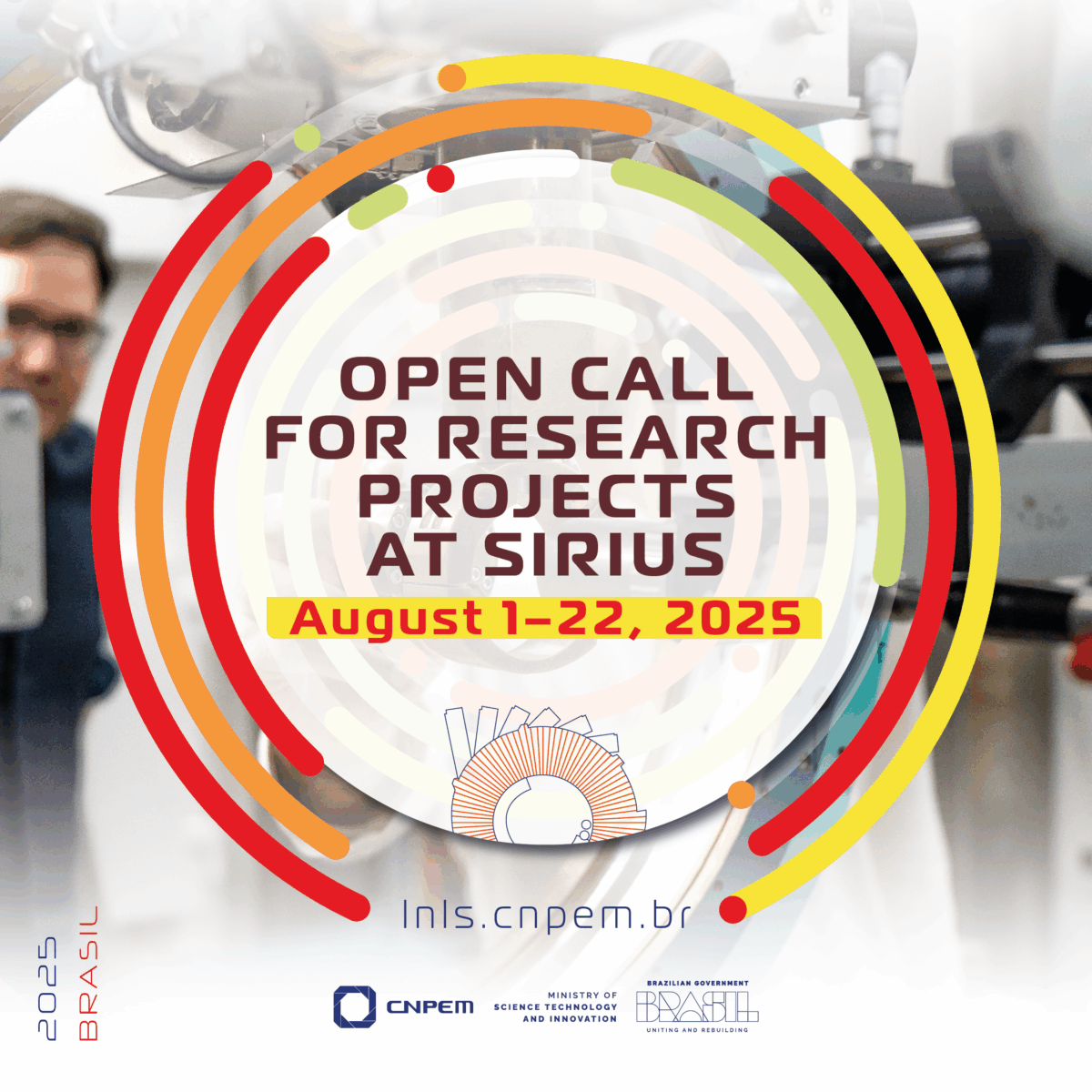
The sixth call for proposals for research at Sirius will run from August 1 to 22, 2025
Proposals can be submitted from August 1 to 22, 2025
The Brazilian Center for Research in Energy and Materials (CNPEM), an organization overseen by the Ministry of Science, Technology and Innovation (MCTI), has opened its sixth regular call for research projects at Sirius, Brazil’s fourth-generation synchrotron light source operated by the Synchrotron Light National Laboratory (LNLS).
Researchers interested in this opportunity can submit their proposals from August 1 to 22 via the SAU Online platform. The results will be announced in November 2025, and the experiments comprising the selected projects will be conducted during the first half of 2026.
There is no cost involved for academic use, and researchers affiliated with institutions in Brazil or countries in Latin America and the Caribbean may also request financial aid for room, board and travel to Campinas, São Paulo, where the CNPEM campus is located.
Ten beamlines are currently operating and ready to receive research proposals as part of this call. Additionally, the Manacá and Cedro beamlines continue to accept project submissions on an ongoing, uninterrupted basis as part of a fast-track system.
The beamlines accepting proposals for this new research cycle are:
Carnaúba: micro and nano-florescence and X-ray spectroscopy and ptychography;
Cateretê: coherent diffraction imaging (ptychography) and X-ray photon correlation spectroscopy (XPCS);
Ema: X-ray diffraction and spectroscopy under extreme conditions of pressure, temperature and magnetic fields;
Imbuia: nano infrared spectroscopy (FTIR);
Ipê: resonant inelastic X-ray scattering (RIXS), X-ray absorption spectroscopy (XAS) and X-ray photoelectron spectroscopy (XPS);
Mogno: X-ray micro and nano-tomography;
Paineira: X-ray diffraction of polycrystalline materials (PXRD);
Sabiá: soft X-ray absorption spectroscopy with magnetic contrast and photoemission microscopy;
Cedro: electronic circular dichroism (CD) spectroscopy in the ultraviolet (UV) range;
Manacá: macromolecular crystallography (MX).
The submitted proposals will be evaluated in a double-blind distributed evaluation process in which the principal investigators (PI) in each call for proposals also serve as reviewers for the other proposals from the community. Each research proposal that is submitted is analyzed by at least five reviewers, and each PI is expected to evaluate five proposals (both new submissions as well as resubmissions).
The quality of these evaluations is also considered in the final scoring for each proposal; missing or superficial technical commentary will result in penalties. The guidelines for the evaluation process can be found at the LNLS User Information page.
As in the fifth call for projects, proposals that received positive evaluations but were not selected may be resubmitted during this sixth call, with 0.2 points automatically added to the original score. To take advantage of this scoring bonus, the proposal must maintain the same content as originally presented, without changes. If the researcher updates the proposal, it must be submitted conventionally as a new proposal (and not a resubmission).
The resubmission option is available on the SAU Online platform. Just as in conventional submissions, the PI for resubmitted proposals must evaluate five projects as an ad hoc reviewer, as described above.
Although they were not included in this regular call for proposals, the Sapucaia and Quati beamlines (dedicated to small-angle X-ray scattering [SAXS] and X-ray absorption spectroscopy [XAS], respectively) are in the commissioning phase. Experiments that will help fine-tune these research stations are planned to take place throughout the second half of 2025, with participation from guest researchers. These beamlines will be available for regular submissions in future calls for proposals.
For more details about the proposal submission process and financial assistance for researchers, please visit the Information for Users page on the LNLS website. Questions can be directed to the User Office via email to edu@cnpem.br.
The Brazilian Center for Research in Energy and Materials (CNPEM) is a state-of-the-art, multi-user and multidisciplinary scientific environment with activities on different fronts within the Brazilian National System for Science, Technology and Innovation. A social organization overseen by the Ministry of Science, Technology and Innovation (MCTI), CNPEM is driven by research that impacts the areas of health, energy, renewable materials, and sustainability and is responsible for Sirius, the country’s largest scientific research infrastructure, CNPEM is currently constructing Project Orion, a laboratory complex for advanced pathogen research. Highly specialized science and engineering teams, sophisticated infrastructure open to the scientific community, strategic lines of investigation, innovative projects involving the productive sector, and training for researchers and students are the pillars of this institution that is unique in Brazil and able to serve as a bridge between knowledge and innovation. Research and development activities at CNPEM are conducted by its National Laboratories in the areas of Synchrotron Light (LNLS), Biosciences (LNBio), Nanotechnology (LNNano), and Biorenewables (LNBR), as well as the Ilum School of Science, which offers a bachelor’s degree program in science and technology with support from the Ministry of Education (MEC). https://cnpem.br/
Infrastructure developed in partnership with Petrobras enables multiscale and automated tomographic imaging of carbonate samples
Change represents a major advance in beamline research capabilities